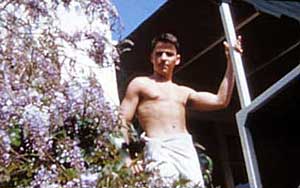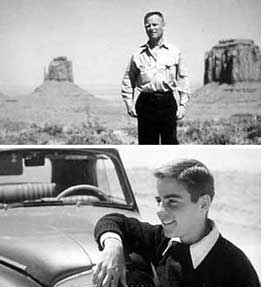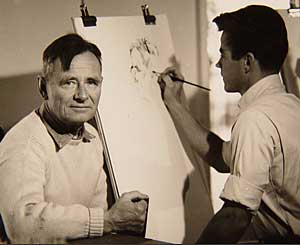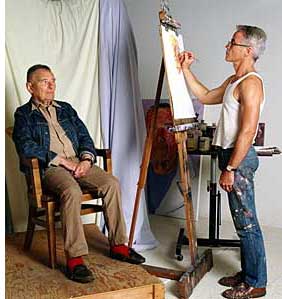
 |
||||||
|
GAY
FILM REVIEWS BY MICHAEL D. KLEMM
|
||||||
|
Chris
& Don Zeitgeist
Films, Directors:
Unrated, 90 minutes |
Longtime
Companions
Chris & Don: A Love Story is a delightful documentary that celebrates one of the most famous longtime 20th century gay marriages - novelist Christopher Isherwood and painter Don Bachardy. Despite a thirty year difference in ages, the two men remained life partners for over three decades. |
 Their
relationship was surprisingly open, if not always tolerated, for the time.
Isherwood fell for Bachardy in 1952 when the lad was only 18. Isherwood
became his mentor; he helped his younger lover fulfill his dream to become
an artist while nourishing his intellect. Several friends remarked on how
Bachardy acquired Isherwood's same mannerisms and speech patterns until
you almost couldn't tell their voices apart (talk about finishing each other's
sentences). Their
relationship was surprisingly open, if not always tolerated, for the time.
Isherwood fell for Bachardy in 1952 when the lad was only 18. Isherwood
became his mentor; he helped his younger lover fulfill his dream to become
an artist while nourishing his intellect. Several friends remarked on how
Bachardy acquired Isherwood's same mannerisms and speech patterns until
you almost couldn't tell their voices apart (talk about finishing each other's
sentences). |
|
|
|
|
 Christopher
Isherwood (1904-1986) is probably best known as the author of Mr. Norris
Changes Trains (1935) and Goodbye To Berlin (1939), which were
the basis of the popular Kander & Ebb musical, Cabaret. These tales
were based on the years that Isherwood spent in Berlin, where he joined
fellow British expatriate W.H. Auden to enjoy the unprecedented sexual freedom
that was rampant before the rise of the Nazis. Isherwood, like Forster,
was uncomfortable with his own class and wanted to experience carnal relations
with a working class foreigner. He left Berlin in 1933 to search for a country
where he could settle down with his German boyfriend - who was eventually
arrested by the Gestapo. Disillusioned by the situation in Europe, he, along
with Auden, emigrated to America in 1939 and settled in California where
he discovered a welcoming melting pot of fellow displaced artists. Christopher
Isherwood (1904-1986) is probably best known as the author of Mr. Norris
Changes Trains (1935) and Goodbye To Berlin (1939), which were
the basis of the popular Kander & Ebb musical, Cabaret. These tales
were based on the years that Isherwood spent in Berlin, where he joined
fellow British expatriate W.H. Auden to enjoy the unprecedented sexual freedom
that was rampant before the rise of the Nazis. Isherwood, like Forster,
was uncomfortable with his own class and wanted to experience carnal relations
with a working class foreigner. He left Berlin in 1933 to search for a country
where he could settle down with his German boyfriend - who was eventually
arrested by the Gestapo. Disillusioned by the situation in Europe, he, along
with Auden, emigrated to America in 1939 and settled in California where
he discovered a welcoming melting pot of fellow displaced artists. |
|
 Bachardy
left home and moved to California with his older brother, Ted, during the
early 1950s in the hopes of becoming an actor. Instead, under the tutelage
and the unwavering support of the renowned author, Bachardy became an accomplished
painter instead. Isherwood deeply loved this young man and was proud that
he was able to mold him as he did. Their relationship was mutually enriching
during a time when gay panic was the norm. They were saddened by their friend,
actor Anthony Perkins, who struggled with his sexuality all his life while
they were so comfortable with their's. They never attended functions with
beards and went everywhere as a couple. Bachardy
left home and moved to California with his older brother, Ted, during the
early 1950s in the hopes of becoming an actor. Instead, under the tutelage
and the unwavering support of the renowned author, Bachardy became an accomplished
painter instead. Isherwood deeply loved this young man and was proud that
he was able to mold him as he did. Their relationship was mutually enriching
during a time when gay panic was the norm. They were saddened by their friend,
actor Anthony Perkins, who struggled with his sexuality all his life while
they were so comfortable with their's. They never attended functions with
beards and went everywhere as a couple. |
|
 Bachardy
shares his many memories; some bitter, some sweet. While enjoying a "honeymoon,"
they visited Monument Valley where John Ford was shooting a Western and
assumed that Isherwood and Bachardy were father and son. He remembers a
party at producer David O. Selznick's home where actor Joseph Cotton was
drunk and railing loudly about disgusting "half men" whenever Bachardy was
in earshot but silent when Isherwood was nearby. Bachardy's anecdotes are
supplemented by various historians. One recounts how Isherwood had moved
into a garden house on the property of psychologist Evelyn Hooker. She had
studied the gay community in Los Angeles and published the first study to
suggest that homosexuals were just as well-adjusted as heterosexuals. But
even she was taken aback when the boyish Bachardy moved in with
Isherwood and they were forced to find other lodgings. Bachardy
shares his many memories; some bitter, some sweet. While enjoying a "honeymoon,"
they visited Monument Valley where John Ford was shooting a Western and
assumed that Isherwood and Bachardy were father and son. He remembers a
party at producer David O. Selznick's home where actor Joseph Cotton was
drunk and railing loudly about disgusting "half men" whenever Bachardy was
in earshot but silent when Isherwood was nearby. Bachardy's anecdotes are
supplemented by various historians. One recounts how Isherwood had moved
into a garden house on the property of psychologist Evelyn Hooker. She had
studied the gay community in Los Angeles and published the first study to
suggest that homosexuals were just as well-adjusted as heterosexuals. But
even she was taken aback when the boyish Bachardy moved in with
Isherwood and they were forced to find other lodgings. |
|
 This
is a very honest documentary as Bachardy spills his guts about many personal
matters. He is quite candid about how, after a few years with Isherwood,
he was jealous of his elder lover's youthful adventures and wanted to experience
a few of his own. The two men agreed to an open marriage and this arrangement
worked for them both. Bachardy would go out "mousing" and Isherwood would
ask him about his experiences while also enjoying a few of his own. But
Bachardy also recounts how, as he came into his own as an artist himself,
he contemplated leaving Isherwood for a younger man. He describes the early
60s as being their "bumpiest period" and that Isherwood's novel about a
lost lover, A Single Man, was written during this time. This
is a very honest documentary as Bachardy spills his guts about many personal
matters. He is quite candid about how, after a few years with Isherwood,
he was jealous of his elder lover's youthful adventures and wanted to experience
a few of his own. The two men agreed to an open marriage and this arrangement
worked for them both. Bachardy would go out "mousing" and Isherwood would
ask him about his experiences while also enjoying a few of his own. But
Bachardy also recounts how, as he came into his own as an artist himself,
he contemplated leaving Isherwood for a younger man. He describes the early
60s as being their "bumpiest period" and that Isherwood's novel about a
lost lover, A Single Man, was written during this time. |
|
 Still,
their relationship would survive. Bachardy stayed with Isherwood until his
death in 1986 from prostate cancer. This is the most moving and emotionally
draining part of the film. Each day, during his extended illness, Isherwood
continued to sit for Bachardy as he drew his portrait. During the last six
months of his life, Isherwood was his partner's only subject. When he couldn't
sit for long periods anymore, Bachardy would capture his likeness in only
a few lines. The montage in which the camera pans across these amazing drawings
beautifully conveys how well the artist captured Isherwood's pain and how
much love he bore for his subject.. Still,
their relationship would survive. Bachardy stayed with Isherwood until his
death in 1986 from prostate cancer. This is the most moving and emotionally
draining part of the film. Each day, during his extended illness, Isherwood
continued to sit for Bachardy as he drew his portrait. During the last six
months of his life, Isherwood was his partner's only subject. When he couldn't
sit for long periods anymore, Bachardy would capture his likeness in only
a few lines. The montage in which the camera pans across these amazing drawings
beautifully conveys how well the artist captured Isherwood's pain and how
much love he bore for his subject.. |
|
 |
|
| Chris & Don benefits from the extensive presence of the surviving partner. He is a mischievous and candid master of ceremonies and his tales are awash with nostalgia. "[Isherwood's] role," says Bachardy, "could be described as that of the arch villain. He took this young boy and he warped him to his mold. He taught him all kinds of wicked things." He pauses, and then with a glint in his eye, laughs and says, "It was exactly what the boy wanted. And he flourished." | |
 The
remaining time is filled with rare home movies and archival footage in which
the lovers are seen with such notables as composer Igor Stravinsky and the
playwright Tennessee Williams on the
set of The Rose Tattoo with Burt Lancaster and Anna Magnani. Excerpts
from Isherwood's extensive diaries are read by actor Michael York - who
played Isherwood's alter ego in Bob Fosse's 1972 film of Cabaret. Using
a coded language between them, Bachardy and Isherwood depicted themselves
as a cat and an old horse and some of their anthropomorphic letters and
cards to each other are presented as cute animated sequences. There are
also a few re-creations, most notably an episode when the two men went to
visit author Paul Bowles in Tangiers. There, they weathered a bad hallucinogenic
experience together which helped to cement their commitment. The
remaining time is filled with rare home movies and archival footage in which
the lovers are seen with such notables as composer Igor Stravinsky and the
playwright Tennessee Williams on the
set of The Rose Tattoo with Burt Lancaster and Anna Magnani. Excerpts
from Isherwood's extensive diaries are read by actor Michael York - who
played Isherwood's alter ego in Bob Fosse's 1972 film of Cabaret. Using
a coded language between them, Bachardy and Isherwood depicted themselves
as a cat and an old horse and some of their anthropomorphic letters and
cards to each other are presented as cute animated sequences. There are
also a few re-creations, most notably an episode when the two men went to
visit author Paul Bowles in Tangiers. There, they weathered a bad hallucinogenic
experience together which helped to cement their commitment. |
|
|
More
on Christopher Isherwood: |